
Image of a woman training with a sword from Manuscript I:33, written 1290
A variety of roles were played by women in post-classical warfare.
Timeline[]

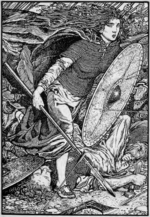
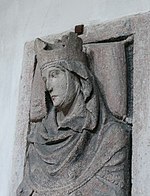
Hemma
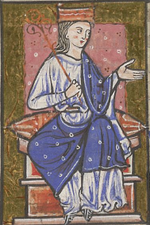


Hōjō Masako
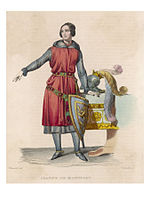

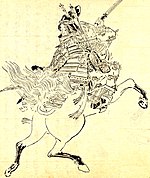


Hulagu Khan with Doquz Khatun


Tribhuwana Wijayatunggadewi


Jadwiga
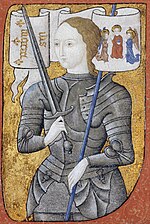
5th century[]
- 451: Saint Genevieve is credited with averting Attila from Paris by rallying the people in prayer.[1]
6th century[]
- 6th century: A Saxon woman is buried with a knife and a shield in Lincolnshire, England.[2]
- 589: The royal nuns Basina, daughter of Chilperic I and Clotilda rebels and take power in the city of Poitiers by the use of an army of criminals.
7th century[]
- 7th century: Khawlah bint al-Azwar participate actively in combat during the Battle of Adnajin dressed as a man.along with several other women, takes command of the Rashidun army at the Battle of Yarmouk against the Roman Byzantine Empire. She was nearly beaten by a Byzantine Greek when one of her female companions, Wafayra, beheaded her opponent with one blow. This act rallied the Arabs and they defeated the Greeks.[3]
- 7th century: Princess Pingyang of China helps overthrow the Sui Dynasty by organizing an "Army of the Lady".[4]
- 7th century: Kahina leads Berber resistance against the Muslim conquest of the Maghreb.[5]
- 624: Qurayshi Arab priestess Hind al-Hunnud leads her people against Muhammad in the Battle of Badr. Her father, uncle, and brother are killed.[6]
- 625: Hind al-Hunnud is among fifteen women accompanying troops in a battle near Medina, singing songs to inspire warriors. She exults over the body of the man who killed her father, chews his liver, and makes jewellery from his skin and nails.[7]
- 625: Nusaybah bint Ka'ab fights in the Battle of Uhud on behalf of Muhammad after converting to Islam.[8] Hammanah bint Jahsh also participated in the Battle of Uhud and provided water to the needy, and treated the wounded and injured.[citation needed] Rumaysa bint Milhan entered the battle carrying a dagger in the folds of her dress, and tended to the wounded. She also made attempts to defend Muhammad when the tide of the battle turned against him.[9]
- 627: Rufaida Al-Aslamia, the first Muslim nurse, attends to the wounded at the Battle of the Trench.[citation needed]Rumaysa bint Milhan also participated, carrying a dagger in her robes. When Muhammad asked her what she was doing with it, she informed him that she planned to use it to fight deserters.[9]
- 632: Prophetess Sajah leads an army to attack Mecca and Medina.
- 634: Umm Hakim single-handedly disposed of seven Byzantine soldiers with a tent pole during the Battle of Marj al-Saffar.[10]
- 656: Aisha, widow of Muhammad, leads troops at the Battle of the Camel. She is defeated.[11]
- 677: Ghazala al-Haruriyya lead troops in battle.
8th century[]
- 8th to 13th century (Viking Age): Sagas and historical records tell of Viking shieldmaidens like Lagertha participating in battles and raids,[12] such as Veborg in the Battle of Brávellir in 750.[13][14]
- 722: Queen Æthelburg of Wessex destroys the town of Taunton.[15]
- 730: A Khazar noblewoman named Parsbit commands an army against Armenia.[16]
9th century[]
- Early 9th century: Cwenthryth wages war against Wulfred, Archbishop of Canterbury, for control of her abbey estates.[17]
- 811: After suffering great losses, Khan Krum mobilizes the women of the Bulgars, who then take part in the Battle of Pliska.[18]
- 840: Norwegian shieldmaiden Lagertha participates in a battle against invading Swedish forces.
- 870s: Queen Hemma leads an army toward Adelchis of Benevento during his uprising against her spouse Louis the German.
- 880: Ermengard of Italy conducts the defense of Vienne until forced to surrender in September 882.[19]
10th century[]
- Mid-10th century: Queen Thyra of Denmark leads an army against the Germans.[20]
- 912–922: Reign of Æthelflæd, queen of Mercia. She commanded armies, fortified towns, and defeated the Danes. She also defeated the Welsh and forced them to pay tribute to her.[21]
- 934: Queen Emma of France dies during a military campaign in which she helped her spouse against his vassals: she was an active army leader.
- 968: Olga of Kiev defends her city during the Siege of Kiev (968).
- 971: Sviatoslav I of Kiev attacked the Byzantine Empire in Bulgaria in 971. When the Varangians were defeated in the siege of Dorostolon, the victors were stunned to discover shieldmaidens among the fallen warriors.[22]
- 975: Adelaide-Blanche of Anjou, acting for her sons Guy and Bertrand, led an army to aid Guy (a.k.a. Guido II), Count-Bishop of le Puy, in establishing the "Peace of God" in le Puy.
- 975: Elvira Ramírez and her nephew leads the Leonese army in the Siege of Moorish Gormaz.
- 986: The Khitan Dowager Regent Empress Xiao Yanyan of the Khitan Liao state, regnal title Chengtian, assumes power at age 30 in 982. In 986, personally led her own army against the Song dynasty in 986 and defeated them in battle,[23][24][25][26][27] fighting the retreating Chinese army. She then ordered the castration of around 100 ethnic Han Chinese boys she had captured in China, supplementing the Khitan's supply of eunuchs to serve at her court, among them was the eunuch Wang Ji'en. The boys were all under ten years old and were selected for their good looks.[28][29][30][31] The History of Liao described and praised Empress Chengtian's capture and mass castration of Chinese boys in a biography on the Chinese eunuch Wang Ji'en.[32][33][34][35][36][37][38][39][40][41][42]
- Late 10th century: Gudit rebels against the Kingdom of Aksum in Ethiopia.[43]
11th century[]
- Early 11th century: Freydís Eiríksdóttir, a Viking woman, sails to Vinland with Þorfinnr "Karlsefni" Þórðarson. When she faced hostile natives while pregnant, she exposed her breasts and beat her chest with a sword. This caused the natives to run away.[44]
- 1047: Akkadevi, an Indian princess, sieges the fort of Gokage.[45]
- 1058–1086: Sikelgaita of Salerno, second wife of Robert Guiscard, Duke of Apulia, accompanies her husband on military campaigns, and regularly puts on full armor and rides into battle at his side.[46]
- 1071: Richilde, Countess of Hainaut is captured fighting in the Battle of Cassel.[47]
- 1072: Urraca of Zamora, Infanta of the Kingdom of Castile, defends the city of Zamora against her brother, Sancho.[48]
- 1075: Emma de Guader, Countess of Norfolk defends Norwich castle while it is under siege.[49]
- 1087: Matilda of Tuscany personally leads a military expedition to Rome in an attempt to install Pope Victor, but the strength of the imperial counterattack soon convinced the pope to retire from the city.
- 1090: Norman woman Isabel of Conches rides armed as a knight.[50]
- 1097: Florine of Burgundy participates in the first crusade with her spouse, and fell participating in actual combat by his side while their army was attacked and destroyed in Anatolia.
12th century[]

- 1101: Ida of Formbach-Ratelnberg leads her own army in the Crusade of 1101.
- 1116: Theresa, Countess of Portugal successfully defends Coimbra against the Moors and are given the title Queen in recognition by the pope.
- 1121:Urraca of León and Castile fights her half-sister, Theresa, Countess of Portugal when she refuses to surrender the city of Tui, Pontevedra.[51]
- 1130: Female Chinese general Liang Hongyu, wife of general Han Shizhong of the Song Dynasty, blocks the advance of the Jin army with her husband. Her drumming invigorated the Song army and rallied them to defeat the Jin.[52]
- 1136: Welsh princess Gwenllian ferch Gruffydd leads an army against the Normans. She is defeated and killed.[53]
- 1141: Matilda of Boulogne raises an army to continue the fight for the crown of England, after her husband, King Stephen is captured by the Empress Matilda.[54]
- 1145: Eleanor of Aquitaine accompanies her husband on the Second Crusade.[55]
- 1148: Melisende, Queen of Jerusalem actively participates in military strategy planning as the head of her troops in the Council in Acre during the Second Crusade.
- 1170-1176: Aoife MacMurrough conducts battles in Ireland on behalf of her consort Richard de Clare, 2nd Earl of Pembroke and is sometimes known as "Red Eva".[56]
- 1172: Alrude Countess of Bertinoro ends a siege of Ancona by leading an army into battle and crushing imperial troops.[57]
- 1172-1218: Umadevi, consort of King Veera Ballala II, functions as a general during campaigns against the Chalukya dynasty and Mysore, commanding armies against the rival Chalukyas on at least two occasions, significantly contributing to the Hoysala Empire's conquest of the Chalukyas at Kalyan (near present day Bidar) in 1190.
- 1179: Elizabeth of Hungary, Duchess of Bohemia successfully defends Prague toward her brother-in-law Sobeslav II as regent during the absence of her spouse. She appeared herself on the battle field with clerical signs on her banner.
- 1180–1185: Female Japanese warrior Tomoe Gozen fights in the Genpei War alongside men.[58]
- 1182-1199: Hōjō Masako rides with her spouse Minamoto no Yoritomo on his campaigns and was never defeated in battle.[59]
- 1184–1212: Reign of queen Tamar of Georgia. Georgia achieved military superiority in the Middle East under her rule.[60]
- 1184: Elizabeth of Hungary, Duchess of Bohemia, for the second time, successfully defends Prague toward her brother-in-law Sobeslav II as regent during the absence of her spouse.
- September 1187: Sibylla, Queen of Jerusalem, personally leads the defense of the city of Jerusalem during the siege of Saladin.
- 1189: Elizabeth of Hungary, Duchess of Bohemia defends Prague toward Conrad II of Bohemia but are forced to surrender and turn over the city.
- 1191: Nicola de la Haye defend the castle of Lincoln, England during a month-long siege.
- 1198: Maud de Braose defends Plainscastle against Welsh attack.
13th century[]
- 1201: Japanese woman Hangaku Gozen defends a fort as an archer until she is killed by an arrow.[61]
- 1217: Nicola de la Haye defend the castle of Lincoln, England during the rebellion of the barons.
- 1221: A daughter of Genghis Khan, Khagan of the Mongol Empire, massacred the residents of Nishapur to avenge the death of her husband who was killed in action.[citation needed]
- 1230: The regent of France, Blanche of Castile, organize and personally lead the French army to subdue a rebel in Brittany.
- 1236-1239: Reign of Razia Sultana,[62] She led her troops in battle.[63]
- 1236-1294: Female warriors attended the campaigns of the Mongols.[citation needed]
- 1258: Doquz Khatun accompanies her husband Hulagu on campaigns. At the Sack of Baghdad in 1258, the Mongols massacred tens of thousands of inhabitants, but by the order of Doquz, the Christians were spared.[64]
- 1261–1289: Reign of Indian queen Rudrama Devi. She leads her troops in battle, and may have been killed in battle in 1289.[65]
- 1264: Eleanor of Provence raises troops in France for her husband during the Baron's War.[66]
- 1270: Eleanor of Castile accompanies her husband on his crusade. According to legend, she saved his life by sucking poison from his wound when he was injured.[67]
- 1271: Isabella of Aragon, Queen of France dies at Cosenza on the way back from the Crusades.[68]
- 1290: Royal Armouries Ms. I.33 is written. It depicts fighters. An illustration of a woman named Walpurgis training in sword and buckler techniques is in the manuscript among others.[69]
- 1296: Bertha van Heukelom defends Castle IJsselstein against Hubrecht van Vianen of Culemborg [70]
- Late 13th century: Khutulun, a relative of Kublai Khan, is described as a superb warrior and accompanies her father Khaidu on military campaigns.[71]
14th century[]
- 14th century: Urduja, a Filipino princess, takes part in several battles. Many historians believe that she was mythical, however.[72]
- 14th century: Joanna of Flanders leads troops into battle.[73] Joan, Duchess of Brittany was among her antagonists.[74]
- 1326: Isabella of France invades England with Roger de Mortimer, and overthrows Edward II of England, replacing him with her son Edward III of England, with her and de Mortimer acting as regents.[75]
- 1331: Queen Tribhuwana Wijayatunggadewi leads her army to crush a rebellion in the areas of Sadeng and Keta.
- 1334: Agnes Randolph successfully defends her castle against a siege by England's earl of Salisbury.[76]
- 1335: During the Second War of Scottish Independence Christina Bruce commanded the garrison of Kildrummy Castle and successfully held the castle against pro-Baliol forces led by David III Strathbogie
- 1335: The Scots defeat a company led by the Count of Namur. Amongst the Count's casualties was a female lancer who had killed her opponent, Richard Shaw, at the same moment that he had killed her. Her gender was only discovered when the bodies were being stripped of their armor at the end of the engagement. "The chronicler Bower seems to have been at least as impressed by the rarity of two mounted soldiers simultaneously transfixing one another with their lances as with the fact that one of them was a woman."[77]
- 1338: Agnes Randolph defense Dunbar Castle against a five months siege by the English.
- 1341: Anna of Trebizond marches to take the throne of Trebizond at the head of an army.
- 1342: Joanna of Flanders conquers the city of Redon and defends the city of Hennebont during the Breton war.
- 1347: Philippa of Hainault persuades her husband not to execute The Burghers of Calais, whom he had defeated.[78]
- 1354: Ibn Battuta reports seeing female warriors in Southeast Asia.[79]
- 1351–1363: Han E serves as a soldier in the Chinese army as a man under the name Han Guanbao, and is promoted to lieutenant.[80]
- 1358: Richardis of Schwerin defends Sönderborg Castle on Als against Valdemar IV of Denmark.[81]
- 1364–1405: Timur uses female archers to defend baggage trains.[79]
- 1387: Queen Jadwiga of Poland leads two military campaigns
- 1389: Frisian regent Foelke Kampana leads armies to assist her spouse Ocko Kenisna tom Brok, chief of Auricherland: after finding him dead on the battlefield, she returns to Aurich, and upon finding it taken by an enemy during her absence, she retakes it by military force[82]
- 1392: Maria, Queen of Sicily, conquers Sicily and defeats the rebelling barons as the leader of an army alongside her consort.
- 1398: Ram Pyari Gurjar was a female commander who fought against Timur, when Timurl invaded the regions from Haridwar to ancient Delhi.
15th century[]
- 15th century: Maire o Ciaragain leads Irish clans in rebellion.[83]
- 15th century: Isabella, Duchess of Lorraine, leads an army to rescue her husband from the Duke of Burgundy.[84]
- 15th century: Mandukhai Khatun takes command of the Mongol army and defeats the Oirats.[85]
- 15th century: Claude des Armoises was a soldier in Italy.[86]
- Mid-15th century: Zaydi Yemeni chieftain Sharifa Fatima conquers San‘a’.[87]
- 1420: Joan of France, Duchess of Brittany, launches war against the Penthievre clan in Brittany and their strongholds one by one until she conquers the last, to free her consort, the duke, who was taken prisoner by the Penthievre.
- 1429: Joan of Arc asserts that God has sent her to drive the English out of France, and is given a position in the French Royal army.[88] She is supported by Yolande of Aragon, mother of Queen Marie d'Anjou (wife of King Charles VII).[89]
- 1433: Ida Königsmarck legendary defense her fief Kastelholm Castle on Åland in Swedish Finland during the Engelbrekt rebellion.
- 1451–1452 : Brita Tott serves as a spy in the war between Sweden and Denmark[90]
- 1455: Elise Eskilsdotter leads a war against the German merchant class of Bergen in Norway as revenge for the murder of her spouse, by means of her pirate fleet.
- 1461: Queen Margaret of Anjou defeats the Earl of Warwick in the Wars of the Roses.[91]
- 1461: Lady Knyvet defends Buckingham Castle at Norfolk against Sir Gilbert of Debenhem.[92]
- 1467: Ólöf Loftsdóttir personally leads the war against the English on Iceland
- 1470: Joanna of Rožmitál leads the Czech army in war
- 1471: Queen Margaret of Anjou is defeated in Battle of Tewkesbury. She and her son escaped to Flanders. The Yorkists eventually captured her and ransomed her to Louis XI, after she had sworn an oath not to go to war anymore.[93]
- 1472: Onorata Rodiana from Cremona, Italy is mortally wounded in battle. She had disguised herself as a man to become a soldier.[94]
- June 27, 1472: Jeanne Hachette rips down the flag of the invading Burgundians at Beauvais, inspiring the garrison to win the fight.[95]
- 1476: Queen Isabella I of Castile personally suppresses the rebellion in Segovia.
- 1481: Dutch noblewoman Swob Sjaarda defends her castle during a siege in the Netherlands.[96]
- 1482-1492: Queen Isabella I of Castile actively participates in the warfare and conquer of Granada.
- 1487: Katarina Nipertz defends Raseborg Castle in Finland, the fief of her late spouse, against the troops of the new vassal appointed by the regent, for several weeks.
- 1494: Ats Bonninga defends her fort in Friesland.[97]
- 1496: Bauck Poppema defends her fort in Friesland.[98]
- 1499: Caterina Sforza successfully defends Forli against a Venetian attack and become famous and nicknamed The Tiger
See also[]
References[]
- ↑ Hayward, John (1857). The Book of Religions: Comprising the Views, Creeds, Sentiments, Or Opinions of all the Principal Sects in the World, Particularly of All Christian Denominations in Europe and America to which are added Church and Missionary Statistics together with Biographical Sketches. Boston: Sanborn, Carter, Bazin and Company. p. 428.
- ↑ "South Carlton Lincolnshire, 25 January 2004: Saxon Burials on the Ridge from channel.4.com". Archived from the original on 2010-12-15. http://www.webcitation.org/5v06nCy23. Retrieved May 7, 2008.
- ↑ Hale, Sarah Josepha Buell (1853). Woman's Record: Or, Sketches of All Distinguished Women, from "The Beginning Till A.D. 1850, Arranged in Four Eras, with Selections from Female Writers of Every Age. Harper Brothers. p. 120.
- ↑ Peterson, Barbara Bennett, editor in chief; He Hong Fei, Wang Jiu, Han Tie, Zhang Guangyu, Associate editors (2000). Notable Women of China: Shang Dynasty to the Early Twentieth Century. M.E. Sharpe Inc., New York. p. 177. ISBN 978-0-7656-0504-7.
- ↑ Hannoum, Abdelmajid (2001). Post-Colonial Memories: The Legend of the Kahina, a North African Heroine (Studies in African Literature). ISBN 978-0-325-00253-8.
- ↑ Olsen, Kirstin (1994). Chronology of women's history. Greenwood Publishing Group. p. 31. ISBN 978-0-313-28803-6.
- ↑ Olsen, p. 31
- ↑ Girl Power. ABC News. Archived 15 December 2010 at WebCite
- ↑ 9.0 9.1 Prophet Muhammad And His Companions. http://books.google.com/books?id=ASH7WKFZnIwC&pg=PA277&dq=Rumaysa+bint+Milhan+battle&hl=en&sa=X&ei=K8BQUYulFOnD0AHIh4GQAg&ved=0CC0Q6AEwAA#v=onepage&q=Rumaysa%20bint%20Milhan%20battle&f=false. Retrieved 2013-07-16.
- ↑ Women and Gender in Islam: Historical Roots of a Modern Debate. http://books.google.com/books?id=U0Grq2BzaUgC&pg=PA70&dq=Umm+Hakim+battle&hl=en&sa=X&ei=Kn9PUaCxMIXj4APyjICwCw&ved=0CDcQ6AEwAQ#v=onepage&q=Umm%20Hakim%20battle&f=false. Retrieved 2013-07-16.
- ↑ Black, Edwin (2004). Banking on Baghdad: Inside Iraq's 7,000 Year History of War, Profit, and Conflict. John Wiley and Sons. p. 34. ISBN 978-0-471-70895-7.
- ↑ Otté, Elise C. (1874). Scandinavian History. Macmillan & co.. p. 28.
- ↑ Macculloch, J.A. (2005). The Celtic and Scandinavian Religions. Cosimo, Inc.. p. 125. ISBN 978-1-59605-416-5.
- ↑ Lindquist, Herman. Historien om Sverige ("History of Sweden"), Book (In Swedish).
- ↑ Jones, David E. (1997). Women Warriors: a history. Brassey's. Dulles, Virginia. p. 57. ISBN 978-1-57488-206-3.
- ↑ Golden, Peter (1980). Khazar Studies: An Historio-Philological Inquiry into the Origins of the Khazars. Budapest: Akademia Kiado.
- ↑ Salmonson, Jessica Amanda (1991). The Encyclopedia of Amazons. Paragon House. p. 66. ISBN 978-1-55778-420-9.
- ↑ Regan, Geoffrey (2000). The Brassey's book of military blunders. Brassey's Inc, Dulles, Virginia. pp. 68. ISBN 1-57488-252-X.
- ↑ Bury,J.B. (1922). Cambridge Medieval History. Macmillan. Vol. III, p. 58; Blair, John; J. Willoughby Rosse (1856). Blair's Chronological Tables, Revised and Enlarged: Comprehending the Chronology and History of the World from the Earliest Times to the Russian Treaty of Peace, April 1856. H.G. Bohn, York Street, Convent Garden, London. p. 300.
- ↑ Salmonson, p. 251
- ↑ King, William C. (1902). Woman; Her Position, Influence, and Achievement Throughout the Civilized World. Her Biography and History. The King-Richardson co., Springfield, Massachusetts. p. 177.
- ↑ Harrison, D. & Svensson, K. (2007). Vikingaliv. Fälth & Hässler, Värnamo. ISBN 978-91-27-35725-9. p. 71
- ↑ Peterson(2000), 259.
- ↑ Derven(2000), 199.
- ↑ Bauer(2010), 569.
- ↑ Wang(2013).
- ↑ Keay(2010).
- ↑ McMahon(2013), 261.
- ↑ McMahon(2013), 269.
- ↑ *The EUNUCHS AND SINICIZATION IN THE NON-HAN CONQUEST DYNASTIES OF CHINA
- JENNIFER W. JAY
- UNIVERSITY OF ALBERTA, Canada
- This paper was presented at the Asian Studies on the Pacific Coast Conference, June 16–18, 1995, at Forest Grove, Oregon, U.S.A. Research for this project was facilitated by a grant from the Social Sciences and Humanities Research Council of Canada. (Although the link is to a forum, the paper is posted in its full length there since it is not available online as it was never published. The following links are to papers and articles where the original paper by Jennifer W. Jay was referenced in the bibliography)
- 5.Jennifer W. Jay. (1995), The Eunuchs And Sinicization In The Non-Han Conquest Dynasties In China, Asian Studies on the Pacific Coast Conference, June 16-18, 1995, at Forest Grove, Oregon, U.S.A.
- "Eunuchs and Sinicization in the Non-Han Conquest Dynasties of China." Selected Papers in ASPAC 1995. Also reprinted in Chinese Culture and Education, Selected Proceedings of the 1995 Annual Meeting of the Chinese-Canadian Academic and Professional Society of Canada, Vancouver, 1995, pp. 25-41.
- Jay, Jennifer W
- University of Alberta, Alberta, Canada
- Eunuchs and Sinicization in the non-Han Conquest Dynasties of China
- [1] [5] Jennifer, W. Jay. The Eunuchs and Sinicization in the Non-Han Conquest of China. A paper presented to the Asian Studies on the Pacific Coast Conference 1995. Not published.]
- ↑ Tuotuo 1974, pp.109.1480-82 (or Liaoshi, 109.1480-82)
- ↑ 国学导航-遼史 (遼史卷一百0九 列傳第三十九)
- ↑ 中国古籍全录 (卷一百一 列传第三十九)
- ↑ 梦远书城 > 辽史 > (卷一百一 列传第三十九)
- ↑ 遼史 卷七一至一百十五 (列傳 第一至四五) (遼 史 卷 一 百 九) (列 傳 第 三 十 九)(伶 官)
- ↑ 辽史-卷一百九列传第三十九 - 文学100
- ↑ 《辽史》作者:脱脱_第115页_全文在线阅读_思兔 - 思兔阅读
- ↑ 王继恩传_白话二十四史 - 中学生读书网 (当前位置:中学生读书网 >> 白话二十四史)
- ↑ 王继恩_英语例句|英文例子|在线翻译_栗子搜!([例句2] 来源:王继恩)
- ↑ 白话辽史-王继恩传 - 文学100
- ↑ 王继恩传
- ↑ 脫脫 (Tuotuo). "遼史/卷109 列傳第39: 伶官 宦官" (in Chinese). 維基文庫 (Chinese Wikisource). http://zh.wikisource.org/wiki/%E9%81%BC%E5%8F%B2/%E5%8D%B7109. Retrieved 5 September 2013.
- ↑ Kessler, David (1996). The Falashas: A Short History of the Ethiopian Jews. Routledge. p. 79. ISBN 978-0-7146-4646-6.
- ↑ Thrapp, Dan L. (1991). Encyclopedia of Frontier Biography: In Three Volumes. University of Nebraska Press. p. 521. ISBN 978-0-8032-9418-9.
- ↑ Campbell, James M; R E Enthoven (1904). Gazetteer of the Bombay Presidency, Volume I, Part II, History of the Konkan Dahkan and Southern Maratha Country. Govt. Central Press, Bombay, India. p. 435.
- ↑ De Pauw, Linda Grant (2000). Battle Cries and Lullabies: Women in War from Prehistory to the Present. University of Oklahoma Press. p. 86. ISBN 978-0-8061-3288-4.
- ↑ Saunders, Corinne J.; Françoise Hazel Marie Le Saux, Neil Thomas (2004). Writing War: Medieval Literary Responses to Warfare. DS Brewer. p. 190. ISBN 978-0-85991-843-5.
- ↑ Williams, Henry Smith (1908). The Historians' History of the World. Hooper & Jackson. p. 611.
- ↑ Salmonson, p.81
- ↑ Edgington, Susan; Sarah Lambert (2002). Gendering the Crusades. Columbia University Press. pp. 53–54. ISBN 978-0-231-12598-7.
- ↑ Stephens, H. Morse (1891). The Story of the Nations: Portugal. New York, G.P Putnam's Sons, London, T. Fisher Unwin. p. 29.
- ↑ Jinhua Dai; Jing Wang, Tani E. Barlow (2002). Cinema and Desire: Feminist Marxism and Cultural Politics in the Work of Dai Jinhua. Verso. p. 147. ISBN 978-1-85984-264-5.
- ↑ Lloyd, Sir John E. (1935). A History of Carmarthenshire. Pub. Caerdydd. p. 140.
- ↑ Marjorie Chibnall, « Matilda (1102–1167) », Oxford Dictionary of National Biography, Oxford University Press, 2004.
- ↑ Weiss, Sonia; Lorna Biddle Rinear, Contributor Adriana Leshko (2002). The Complete Idiot's Guide to Women's History. Alpha Books. p. 87. ISBN 978-0-02-864201-7.
- ↑ Salmonson, p. 160
- ↑ Salmonson, p. 7
- ↑ Deal, William E. (2007). Handbook to Life in Medieval and Early Modern Japan. Oxford University Press, US. p. 48. ISBN 978-0-19-533126-4. http://books.google.com/books?id=i0ni1NmbYe0C&dq=Handbook+to+Life+in+Medieval+and+Early+Modern+Japan&source=gbs_navlinks_s.
- ↑ Jones 1997, pp. 37–38
- ↑ Kaufman, Stuart J. (2001). Modern Hatreds: The Symbolic Politics of Ethnic War. Cornell University Press. p. 91. ISBN 978-0-8014-8736-1.
- ↑ Friday, Karl F. (2003). Samurai, Warfare and the State in Early Medieval Japan: a military study. Routledge. p. 193. ISBN 978-0-415-32962-0.
- ↑ The Pearson Guide To The Central Police Forces Examination, 2/E By Thorpe, p.3.8, written 2010
- ↑ History of the Panjáb from the Remotest Antiquity to the Present Time By Muḥammad Laṭīf (Saiyid, khān bahādur.), p.98 Written 1891.
- ↑ "A history of the Crusades", Steven Runciman, ISBN 978-0-14-013705-7, p.303
- ↑ Ramusack, Barbara N.; Sharon L. Sievers (1999). Women in Asia: Restoring Women to History. Indiana University Press. ISBN 978-0-253-21267-2.
- ↑ Houghton Mifflin Company; Justin Kaplan (2003). The Houghton Mifflin Dictionary of Biography. p. 487. ISBN 0-618-25210-X.
- ↑ Low, Sidney James; Frederick Sanders Pulling (1910). The Dictionary of English History. Cassell and Company Limited, London, New York, Toronto, and Melbourne. p. 421.
- ↑ Williamson, Paul (1998). Gothic Sculpture, 1140-1300. Yale University Press. p. 171. ISBN 0300074522.
- ↑ Bachmann, Dieter (2003). "I.33". Archived from the original on 2010-12-15. http://www.webcitation.org/5v06oYdJg. Retrieved 2008-06-20.
- ↑ Heukelom, Bertha van (?-1322)
- ↑ Rossabi, Morris (1989). Khubilai Khan: His Life and Times. University of California Press. pp. 104–105. ISBN 978-0-520-06740-0.
- ↑ Apeles, Teena (2004). Women Warriors: Adventures from History's Greatest Female Fighters. Seal Press. p. 65. ISBN 978-1-58005-111-8.
- ↑ Salmonson, 131-132
- ↑ Salmonson, 132
- ↑ American Heritage Dictionary Editors (2005). The Riverside Dictionary of Biography. Houghton Mifflin Reference Books. p. 410. ISBN 978-0-618-49337-1.
- ↑ Salmonson, p.34
- ↑ Brown, Chris (2006). The Second Scottish Wars of Independence.. Tempus Publishing.. p. 60. ISBN 978-0-7524-3812-2.
- ↑ Bradbury, Jim (2004). The Routledge Companion to Medieval Warfare. Routledge. p. 199. ISBN 978-0-415-22126-9.
- ↑ 79.0 79.1 Svinth, Joseph R.. "Women's Martial Arts: A Chronological History, 479 BCE-1896 CE.". Electronic Journals of Martial Arts and Sciences Guelph School of Japanese Sword Arts, July 2003. Archived from the original on 2010-12-15. http://www.webcitation.org/5v06oq2Wk. Retrieved 2008-06-27.
- ↑ "Han E - the 'Hua Mulan' of Sichuan Province". Colorq.org. Archived from the original on 2010-12-15. http://www.webcitation.org/5v06p497z. Retrieved 2008-06-03.
- ↑ 86 (Dansk biografisk Lexikon / XIV. Bind. Resen - Saxtrup)
- ↑ Kampana, Foelke (ca. 1355-1417/1419)
- ↑ Salmonson, p. 163
- ↑ Salmonson, p.126-7
- ↑ Davis-Kimball, Jeannine (2002). Warrior Women, An Archaeologist's Search for History's Hidden Heroines. Warner Books Inc.. pp. 226–228. ISBN 978-0-446-52546-6.
- ↑ Quest for the past. Pleasantville: Reader's Digest Association. 1984. p. 298. ISBN 0-89577-170-5.
- ↑ Mernissi, Fatima, translated by Mary Jo Lakeland (1997). The Forgotten Queens of Islam. University of Minnesota Press. p. 20. ISBN 978-0-8166-2439-3.
- ↑ Pernoud, Regine (1982). Joan of Arc By Herself And Her Witnesses. Scarborough House.
- ↑ Berents, p.32
- ↑ Wilhelmina Stålberg: Anteqningar om Svenska kvinnor (Notes on Swedish women) (Swedish)
- ↑ Salmonson, p.166
- ↑ "The Secret History of Women". Sunday Mirror. January 2, 2000. http://findarticles.com/p/articles/mi_qn4161/is_20000102/ai_n9706473. Retrieved 2008-06-20.
- ↑ Salmonson, p.166-167
- ↑ Waters, Clara Erskine Clement (1886). Stories of Art and Artists. Ticknor and company. pp. 86–87.
- ↑ The Encyclopædia Britannica: A Dictionary of Arts, Sciences, Literature and General Information, eleventh edition, volume XII. Cambridge, England, at the University Press, New York 35 West 32nd street. 1910. p. 793.
- ↑ Sjaarda, Swob (ca. 1435-1520)
- ↑ Bonninga, Ats (?-na 1494)
- ↑ Poppema, Bauck (?-1501)
Surveys[]
- De Pauw, Linda Grant. Battle Cries and Lullabies: Women in War from Prehistory to the Present (University of Oklahoma Press, 1998), popular history by a leading scholar
- Fraser, Antonia. The Warrior Queens (Vintage Books, 1990)
Medieval[]
- Bauer, Susan Wise (2010). The History of the Medieval World: From the Conversion of Constantine to the First Crusade (illustrated ed.). W. W. Norton. ISBN 0393078175. http://books.google.com/books?id=1u2oP2RihIgCformat.
- Blythe, James M. "Women in the Military: Scholastic Arguments and Medieval Images of Female Warriors," History of Political Thought (2001), v.22 pp. 242–69.
- Edgington, Susan B. and Sarah Lambert, eds. Gendering the Crusades (2002), 13 scholarly articles
- Hacker, Barton C. "Women and Military Institutions in Early Modern Europe: A Reconnaissance," Signs (1981), v6 pp. 643–71.
- Hay, David. "Canon Laws Regarding Female Military Commanders up to the Time of Gratian: Some Texts and their Historical Contexts", in A Great Effusion of Blood’? Interpreting Medieval Violence, eds. Mark D. Meyerson, et al. (University of Toronto Press, 2004), pp. 287–313.
- Hay, David. The Military Leadership of Matilda of Canossa, 1046-1115 (Manchester University Press, 2008).
- Hingley, Richard, and Unwin, Christina. Boudica: Iron Age Warrior Queen (2006).
- Illston, James Michael. 'An Entirely Masculine Activity’? Women and War in the High and Late Middle Ages Reconsidered (MA thesis, University of Canterbury, 2009) full text online, with detailed review of the literature
- Lourie, E. "Black women warriors in the Muslim army besieging Valencia and the Cid’s victory: A problem of interpretation," Traditio, 55 (2000), 181–209
- McLaughlin, Megan. "The Woman Warrior: Gender, Warfare and Society in Medieval Europe," Women’s Studies 17 (1990), pp. 193-209.
- Maier, C.T. "The roles of women in the crusade movement: a survey" Journal of medieval history (2004). 30#1 pp 61-82
- Nicholson, Helen. "Women on the Third Crusade," Journal of Medieval History 23 (1997), pp. 335-49.
- Solterer, Helen. "Figures of Female Militancy in Medieval France," Signs 16 (1991), pp. 522-49.
- Tuotuo. Liaoshi [History of Liao]. Beijing: Zhonghua shuju, 1974 (or Tuotuo, Liaoshi (Beijing: Zhonghua shuju, 1974))
- Verbruggen, J.F. "Women in Medieval Armies," Journal of Medieval Military History 4 (2006), pp. 119–36.
China[]
- Keay, John (2010). China: A History. HarperCollins UK. ISBN 0007372086. http://books.google.com/books?id=fcy1N5GXs4wC.
- McMahon, Keith (2013). Women Shall Not Rule: Imperial Wives and Concubines in China from Han to Liao. Rowman & Littlefield Publishers. ISBN 1442222905. http://books.google.com/books?id=gc_3IXkwG3QC.
- Peterson, Barbara Bennett, ed (2000). Notable Women of China: Shang Dynasty to the Early Twentieth Century (illustrated ed.). M.E. Sharpe. ISBN 0765619296. http://books.google.com/books?id=KLNrqn4WLZYC.
- (Chinese) Toqto'a et al. (1344). Liao Shi (宋史) [History of Liao].
- Van Derven, H. J., ed (2000). Warfare in Chinese History. Volume 47 of Sinica Leidensia / Sinica Leidensia (illustrated ed.). BRILL. ISBN 9004117741. http://books.google.com/books?id=IXKkCXDvYFYC.
- Wang, Yuan-Kang (2013). Harmony and War: Confucian Culture and Chinese Power Politics (illustrated ed.). Columbia University Press. ISBN 0231522401. http://books.google.com/books?id=gxVfTuKsaJQC.
| Wikimedia Commons has media related to Women in the military. |
The original article can be found at Women in post-classical warfare and the edit history here.